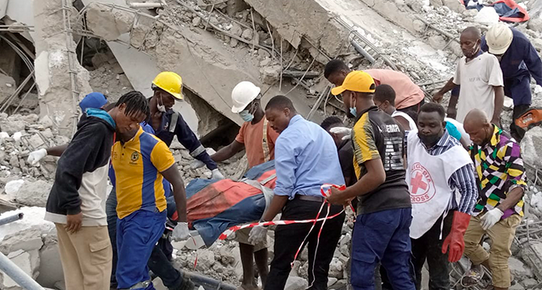Breaking News
Death toll rises to 15 in Ikoyi building Collapse

Fifteen persons have been confirmed killed and more survivors rescued hours after a high-rise building collapsed in the Ikoyi area of Lagos State.
The incident which occurred on Monday afternoon along Wesley Road in the commercial hub of Ikoyi, Lagos State brought down the uncompleted 21-storey building with an uncounted number of persons trapped inside.
While four persons were killed and five others rescued as of Monday night, the death toll and number of survivors rose on Tuesday as rescue efforts continued through the night.
According to the spokesman for the National Emergency Management Agency (NEMA), 11 more bodies have been recovered.
He added that five more persons trapped under the rubble have been rescued by emergency responders at the scene.
This brings the total figures of those killed and rescued so far to 15 and 10 respectively.
The Deputy Governor of Lagos, Dr Obafemi Hamzat, who visited the site amid tight security, explained that the premise of the collapsed building has been sealed by the government agency in charge of testing, for more investigation into the integrity of the structure.
Meanwhile, Lagos State Governor, Babajide Sanwo-Olu, on Tuesday directed the indefinite suspension of the General Manager of the Lagos State Building Control Agency, Mr. Gbolahan Oki.
His suspension comes about 24 hours after a high-rise building collapsed in the Ikoyi area of the state.
The Governor, in a statement signed by Commissioner for Information, Gbenga Omotoso, described the suspension as a “first step” towards finding out “what went wrong” to cause the building collapse.
The State Government is also setting up an independent panel to probe the collapse.
“Members of the panel will be drawn from the Nigeria Institute of Architects (NIA), Nigerian Institute of Town Planners (NITP), Nigeria Society of Engineers (NSE) and other professional bodies,” the statement said.
“It will independently investigate the remote and immediate causes of the incident and make recommendations on how to prevent future occurrence. The investigation is not part of the internal probe already being conducted by the government.”
“Mr. Sanwo-Olu thanks all first responders and those who have joined the rescue efforts, including construction giants Julius Berger, Chinese Civil Engineering Construction Corporation (CCECC) and the National Emergency Management Agency (NEMA),” the statement said.
“A help desk is to be set up at the site for people seeking information about their relations who may have been involved in the incident. The media are hereby notified that the government will be releasing information whenever the need arises to avoid any sensational reporting of the unfortunate incident.”
Furthermore, the Chairman of the Nigerian Institute of Architects, Lagos State Chapter, David Majekodunmi, also visited the site of the building collapse.
He lamented that unfortunate incidents such as this should not have happened if authorities had done what was expected of them.
“My first impression is that the country is in a mess. We are in a mess because if we have done what we are supposed to do, either on the private or government side, we wouldn’t be having this kind of incident.
“Like it’s said by (Femi) Falana, the renowned lawyer, about six or seven weeks precisely where we have all the allied professionals in the construction industry together, he said ‘we should stop talking about building collapse; go and search yourselves, what is your regulatory building doing? Your regulatory body is supposed to regulate things like this,” said Majekodunmi.
He added, “Looking at this, you can’t determine what is actually the cause of the collapse. In a nutshell, we are standing in front of the signage which is supposed to be a prerequisite at a site.
“You cannot see the name of the architect, the structural engineer, and other consultants. But there is so much going on on the platform where the number written on all these consultants happens to be the developer.
“I will tell you just a little history because the government has a big fault for this. In 1986, a National Building Code was drafted by all the professional bodies in the construction industry – seven of them. This National Building Code was not signed until 20 years after it was drafted.”






